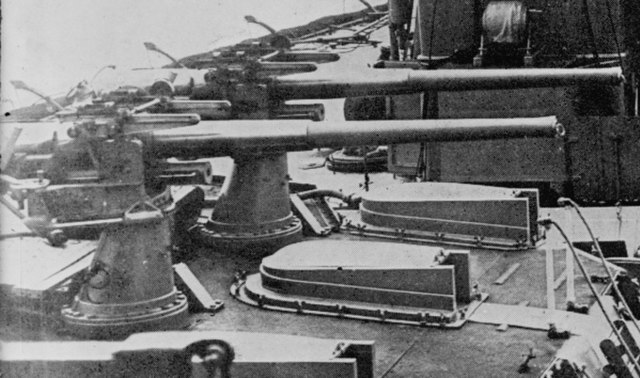Pennsylvania-class battleship
The Pennsylvania class consisted of two super-dreadnought battleships built for the United States Navy just before the First World War. Named Pennsylvania and Arizona, after the American states of the same names, the two battleships were the United States' second battleship design to adhere to the "all or nothing" armor scheme. They were the newest American capital ships when the United States entered the First World War.
Arizona at the United States' post-First World War naval review in New York, December 1918
The Nevada class, represented here by Oklahoma in 1916, were the first American battleship class with triple gun turrets, the "all or nothing" armor concept, oil fuel, and steam turbines with geared cruising turbines (albeit the latter only in Nevada); all of these innovations were continued in the Pennsylvania class.
Arizona's starboard propeller shaft
Pennsylvania on a visit to Australia, 1925
The dreadnought was the predominant type of battleship in the early 20th century. The first of the kind, the Royal Navy's HMS Dreadnought, had such an effect when launched in 1906 that similar battleships built after her were referred to as "dreadnoughts", and earlier battleships became known as pre-dreadnoughts. Her design had two revolutionary features: an "all-big-gun" armament scheme, with an unprecedented number of heavy-calibre guns, and steam turbine propulsion. As dreadnoughts became a crucial symbol of national power, the arrival of these new warships renewed the naval arms race between the United Kingdom and Germany. Dreadnought races sprang up around the world, including in South America, lasting up to the beginning of World War I. Successive designs increased rapidly in size and made use of improvements in armament, armour, and propulsion throughout the dreadnought era. Within five years, new battleships outclassed Dreadnought herself. These more powerful vessels were known as "super-dreadnoughts". Most of the original dreadnoughts were scrapped after the end of World War I under the terms of the Washington Naval Treaty, but many of the newer super-dreadnoughts continued serving throughout World War II.

The Royal Navy's revolutionary HMS Dreadnought, launched in 1906, gave its name to the type
USS Texas, the only dreadnought still in existence, was launched in 1912 and is now a museum ship
12-pounder anti-torpedo boat guns mounted on the roof of a turret on Dreadnought (1906)
King George V (left) inspects HMS Neptune








